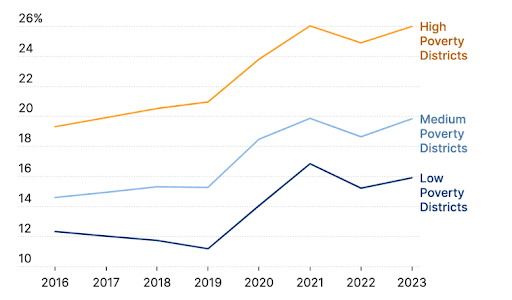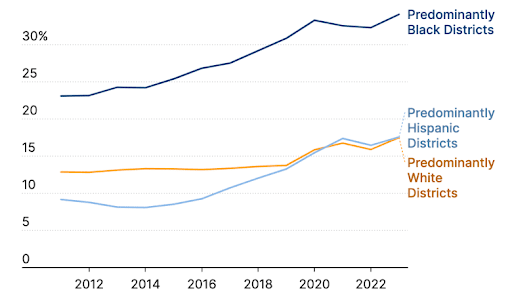Source: Brookings, “Decreasing public school enrollment,” August 2025
Private school enrollment level
Before the pandemic, the share of students in typical public institutions held consistent, hovering near 85 percent between 2016 and 2020 After the pandemic, conventional public institution enrollment plunged to below 80 percent and hasn’t rebounded.
The mysterious absent children represent a big portion of the decrease. Yet family members likewise switched over to charter and online colleges. Charter college enrollment increased from 5 percent of students in 2016 – 17 to 6 percent in 2023 – 24 The variety of children attending digital colleges almost doubled from 0. 7 percent prior to the pandemic in 2019 – 20 to 1 2 percent in 2020 – 21 and has remained elevated.
Surprisingly, independent school enrollment has stayed consistent at virtually 9 percent of school-age kids between 2016 – 17 and 2023 – 24, according to this Brookings estimate.
I had actually expected private school registration to skyrocket, as family members soured on public institution interruptions during the pandemic, and as 11 states, including Arizona and Florida, released their own instructional savings account or new coupon programs to aid pay the tuition. However one more analysis , launched this month by scientists at Tulane College, echoed the Brookings numbers. It located that private school enrollments had actually enhanced by only 3 to 4 percent between 2021 and 2024, compared to states without coupons. A new federal tax obligation credit rating to money independent school scholarships is still even more than a year away from going into effect on Jan. 1, 2027, and possibly a better change into private education is still ahead.
Defections from conventional public schools are biggest in Black and high-poverty districts
I would have presumed that wealthier households that can manage private school tuition would certainly be most likely to look for options. But high-poverty areas had the largest share of pupils outside the traditional public-school market. In addition to private school, they were registered in charters, online institutions, specialized schools for students with specials needs or various other alternate institutions, or were homeschooling.
More than 1 in 4 pupils in high-poverty areas aren’t registered in a conventional public college, compared with 1 in 6 students in low-poverty school areas. The steepest public college enrollment losses are concentrated in primarily Black college districts. A 3rd of pupils in mainly Black districts are not in conventional public institutions, double the share of white and Hispanic pupils.
Share of student enrollment outside of traditional public institutions, by area poverty

Source: Brookings, “Decreasing public institution registration,” August 2025
Share of pupils not enlisted in typical public institutions by race and ethnic culture

Source: Brookings, “Decreasing public institution enrollment,” August 2025
These inconsistencies issue for the students who remain in traditional public schools. Institutions in low-income and Black areas are currently shedding the most trainees, requiring even steeper budget cuts.
The market timebomb
Before the pandemic, U.S. schools were already gone to a big contraction. The typical American lady is currently giving birth to just 1 7 kids over her lifetime, well listed below the 2 1 fertility price needed to change the populace. Fertility rates are predicted to fall further still. The Brookings experts think even more immigrants will certainly continue to enter the country, despite present migration constraints, yet inadequate to counter the decrease in births.
Also if households go back to their pre-pandemic registration patterns, the population decline would certainly imply 2 2 million fewer public school pupils by 2050 Yet if moms and dads maintain picking various other kinds of institutions at the speed observed since 2020, conventional public schools could shed as several as 8 5 million pupils, avoiding 43 06 million in 2023 – 24 to as few as 34 57 million by mid-century.
Between students gone missing, the options some Black family members and family members in high-poverty districts are making and how many kids are being birthed, the public college landscape is changing. Twist up and prepare yourself for mass public college closures
This story regarding college registration declines was produced by The Hechinger Record , a not-for-profit, independent wire service concentrated on inequality and technology in education and learning. Enroll in Evidence Points and various other Hechinger e-newsletters